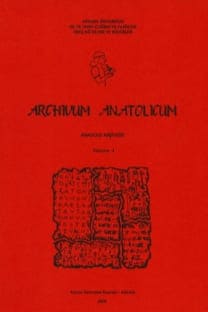Kahramanmaraş’tan Aramca Bir Kil Etiket
Kahramanmaraş’ta bulunmuş küçük bir Yeni Asurca metin grubu içinde,
36-25-07 envanter numaralı Arami alfabe yazılı bir kil tablet vardır. Tarafıma
gönderilen tabletin renki fotoğrafları sayesinde metni detaylı bir şekilde
inceledim. Maalesef aşağıda ayrıntılı şekilde belirtileceği üzere, tabletin
yazılı kısmının bir bölümünde silinti mevcuttur. Ayrıca yazı bir şekilde
tabletin köşe ve kenarlarında yayvan bir şekilde yazılmıştır. Bu iki unsur (ki
kaliteli fotoğraflara rağmen kısmen yanıltıcıdır) hem işaretlerin mâkul
bir şekilde okunabilmesi için gereken zamana ihtiyaç doğurmuştur hem de yazıtın
etraflıca yorumlanmasını olumsuz yönde etkilemiştir. Tabletin gözleme dayalı
olarak, yani doğrudan elle tutularak incelenmesi, daha fazla ve sağlıklı sonuçlar
elde edilmesini sağlayabilir; fakat –hala belirsiz olsa da- bu şekliyle
tanıtılabilir.
Anahtar Kelimeler:
Marqasi, Yeni Asur Dönemi, Aramca, Aramca etiket, Marqasi
An Aramaic Docket on Clay from Kahramanmaraş
Within the small corpus of texts of Neo-Assyrian date from Kahramanmaraş,
there is a clay tablet in Aramaic alphabetic script, bearing the inventory number
36-25-07. I have
examined the text in detail through a set of color photographs, which were
kindly provided to me. Unfortunately, as will be said in detail below, the piece presents some abrasions on its written surface, and the script tends
moreover to “snake” somewhat around the corners and folds of the clay; these
two factors (which partially deceive even good photographic reproductions) have
thus influenced negatively both the time required to establish an acceptable
reading of the signs, and the overall interpretation of the inscription. An
autoptic, i.e. direct, the examination of the tablet might yield some further
results; but for the time being, the present – still rather tentative – version
may be offered.
Keywords:
Neo-Assyrian Period, Aramaic, Aramaic Docket, Marqasi,
___
- Günbattı, C.-Çeçen, S.-Gökçek, L.G.-Akyüz, F., (in press), Kahramanmaraş’ta Bulunmuş Yeni Asurca Tabletler, Türk Tarih Kurumu Yayınları, Ankara.
- DNWSI = J. Hoftijzer - K. Jongeling, Dictionary of the North-West Semitic Inscriptions, I-II, Leiden- New York – Köln 1995 (by page number).
- Fales, F.M. (1986), Aramaic Epigraphs on Clay Tablets of the Neo-Assyrian Period, Roma.
- Fales, F.M. (2013), Review of Lipiński 2010, BiOr 70, 204-210.
- Fales, F.M. - K. Radner – C. Pappi – E. Attardo (2005), The Assyrian and Aramaic Texts from Tell Shiukh.
- Fawqani, in L. Bachelot – F.M. Fales (Eds.), Tell Shiukh Fawqani 1994-1998, Padua, II, 595-694.
- Jiménez, E. – S. F. Adalı – K, Radner (2015), Four 7th-Century BCE Neo-Assyrian Slave Sale Records from Marqasi (Kahramanmaraş) in the Erimtan Museum (Ankara) and Elsewhere, AoF 42, 153-172.
- Jiménez, E. – A. Fıstıkçı – S.F. Adali (2015), Two 7th-Century BCE Neo-Assyrian Slave Sale Records from Marqasi (Kahramanmaraş) in a Collection at Gaziantep, AoF 42, 173-183.
- Lemaire, A. (2001), Nouvelles tablettes araméennes, Genève.
- Lieberman, S.J. (1968), The Aramaic Argillary Script in the Seventh Century, BASOR 192, 25-31.
- Lipiński, E. (2010), Studies in Aramaic Inscriptions and Onomastics, Volume III: Ma’lana, LeuvenPNA = K. Radner, H.D. Baker (Eds.), The Prosopography of the Neo-Assyrian Empire, I–III, Helsinki 1998–2011 (by page nos.).
- Postgate, J.N. (1976), Fifty Neo-Assyrian Legal Documents, Warminster.
- Radner, K. (1997), Die neuassyrischen Privatrechtsurkunden als Quelle für Mensch und Umwelt, Helsinki.
- Röllig, W. (2014), Die aramäischen Texte aus Tall Šēḫ Ḥamad /Dūr Katlimmu / Magdalu, Wiesbaden.
- Zadok, R. (1977), On West Semites in Babylonia during the Chaldean and Achaemenian Periods: an Onomastic Study, Jerusalem.
- ISSN: 1300-6355
- Yayın Aralığı: Yılda 2 Sayı
- Başlangıç: 1995
- Yayıncı: Ankara Üniversitesi
Sayıdaki Diğer Makaleler
Kuzey Lykia’dan Yeni Bir Yapı Yazıtı
Bülent İplikçioğlu, Ayşe YAKUT
Çivi Yazılı Belgeler ve Arkeolojik Verilere Göre Eski Babil Döneminde Nehir Ulaşımı
İrfan ALBAYRAK, Esma ÖZ, Hakan EROL
Yeni Asur Döneminden Yeni Bir Limmu Adı ve Tarihi Üzerine Değerlendirme
Eski Mezopotamya Kültüründe Tılsım İnanışı ve Bazı Tılsımlı Objeler
Kahramanmaraş’tan Aramca Bir Kil Etiket
